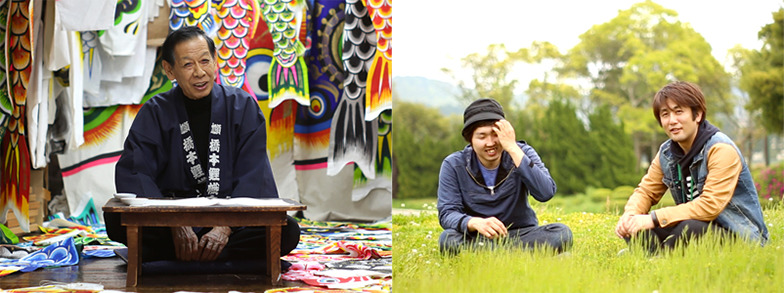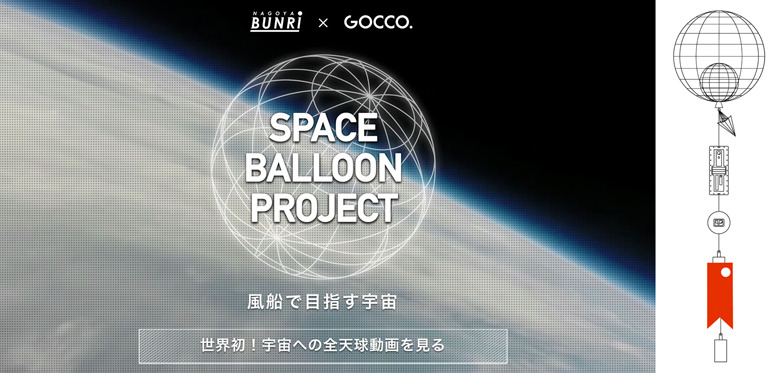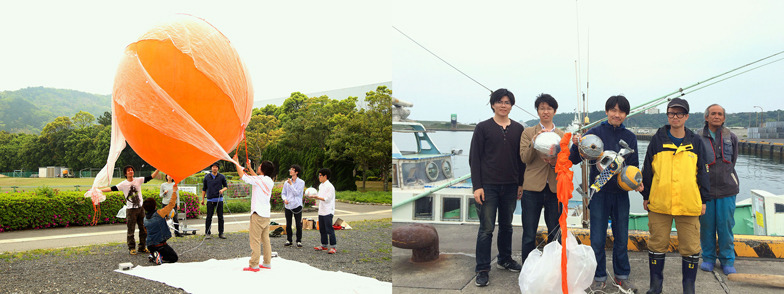The "Good JAPAN Innovation" project brings together Japan's finest craftsmanship and Dentsu Inc. art directors under the theme "Traditional Crafts × Design" to create collaborative works and share new value with the world. The second installment features a collaboration between hand-painted carp streamers from Saitama Prefecture and technology.
Approximately 30,000 meters above ground, "Koinobori Higher Than the Sky"
Koinobori, which color the Boys' Festival, originate from the legend of "carp swimming upstream," a symbol of success and advancement. If they're going to climb, they should climb as high as possible. That's probably more auspicious.
This photo was taken with that idea in mind. We commissioned artisans to create a special koi carp banner, then launched a balloon carrying a camera and the banner to photograph it in the stratosphere. While it sounds simple, it actually involved a lot of people going out of their way.

To those who made this possible: From left, carp streamer artisan Mr. Hashimoto, and Mr. Mizuguchi and Mr. Sahara from GOCCO., who handled the launch.
An era where you can easily launch things toward space
The inspiration came from the SPACE BALOON PROJECT ( http://goccojapan.com/sbp/ ) shown to us by the Gifu-based digital creative group GOCCO. ( http://goccojapan.com). Videos using balloon satellites for weather observation aren't particularly rare; overseas, even elementary school students upload videos of their launches. Until this project, I didn't know Japan had launch experience either, but apparently they have a track record of sending them into the stratosphere multiple times for TV program filming and such.
Incidentally, the principle is:
The buoyancy of a helium-filled balloon lifts it into the sky.
↓
At higher altitudes where air pressure decreases, the helium expands, causing the balloon to burst.
↓
It descends to the surface (sea) via parachute.
That's the gist.
With that rough understanding, I approached GOCCO. about this project.

SPACE BALOON PROJECT (left) Conceptual design sketch from the planning phase (right)
Sorry for saying it would be easy.
As we discussed plans for implementation, it became clear this project wasn't simple at all.
・Japan has restrictions under the Radio Law and Aviation Law.
・Japan has densely populated areas, so we can't let the balloon land in the wrong place.
・Therefore, we must meticulously simulate and determine the launch site by working backward from the landing location.
・Balloon trajectories are heavily influenced by wind, so the launch date and location cannot be finalized until the last minute (2-3 days prior).
・The camera unit must be robust yet delicate to withstand changes in air pressure and temperature.
・Special care is needed to secure the subject so the carp streamers don't tangle with the balloon and still fit within the camera's frame, while also adhering to weight restrictions.
・Real-time GPS analysis tracks the balloon's path, guiding a small fishing boat to the predicted landing spot (at sea). Beginners usually end up throwing up.
・Even with GPS, locating the small balloon unit in the vast ocean requires hours of searching. Sometimes it remains unfound.
etc…
We had underestimated it, thinking "even elementary school kids can do this," but it turned out we needed to mobilize far more technology, know-how, and personnel than anticipated. That said, thanks to the experience of the GOCCO. team and SPACE BALOON PROJECT leader Mr. Sahara in pioneering balloon launches in Japan, we've gained a clear understanding of the general procedure.

Just before balloon launch @ Mie (left) Recovery team members @ Shizuoka (right)
Challenging the limits of hand-painted carp streamers
In Kazo City, Saitama Prefecture—Japan's top producer of carp streamers—the Hashimoto Yakichi Shoten continues to uphold the tradition of hand-painting. When we approached the third-generation owner, Takashi Hashimoto, he readily agreed to collaborate. The workshop is crammed with carp streamers of every color and pattern.

Hashimoto Yakichi Shoten Workshop
"While grounded in traditional techniques, we constantly develop and experiment with new colors and patterns," says Mr. Hashimoto. New designs often emerge in response to requests from visiting customers. The word "tradition" might evoke an image of making things unchanged since ancient times, but as Mr. Hashimoto puts it, "Isn't the ability to respond to details precisely what makes hand-painting so valuable?"
While most hand-painters shifted to nylon printing with the times, it was precisely Hashimoto's flexible approach—avoiding rigid adherence to traditional techniques—that allowed him alone to preserve the tradition of "hand-painting." It was because of this very quality in Hashimoto that we could entrust our request to him with confidence.
"Could you draw an ultra-miniature koi nobori for us?"

Mr. Hashimoto painting an ultra-mini hand-painted koi banner, just 30cm long
Even the smallest hand-painted carp streamers crafted by Mr. Hashimoto measure about 1 meter. After prior verification, the size of the carp streamer mountable on the balloon this time was 30 centimeters in total length.
We requested he create this mini-size koi banner—without even a stencil—where his skill lies in techniques like "blurring" and "fading." Despite this, Mr. Hashimoto used an ultra-fine brush to apply a design densely packed with patterns. Standing before this remarkably powerful hand-painted koi banner, hard to believe it was only 30 centimeters, we felt anew the potential of traditional craftsmanship.
And so, all preparations were complete. Now, let us raise this wonderful, fading Japanese tradition higher than the sky!
World's first!? A koi nobori into the stratosphere.
This "Koinobori Higher Than the Sky," realized through the efforts of many people and their skills. Please enjoy the video capturing its actual flight.
Making-of Movie







